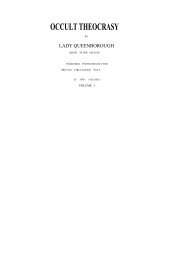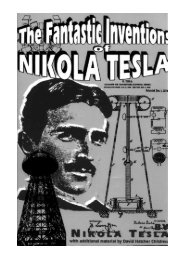the fantastic inventions of nikola tesla - Exopolitics Hong Kong
the fantastic inventions of nikola tesla - Exopolitics Hong Kong
the fantastic inventions of nikola tesla - Exopolitics Hong Kong
You also want an ePaper? Increase the reach of your titles
YUMPU automatically turns print PDFs into web optimized ePapers that Google loves.
produced by <strong>the</strong> force is small: hence <strong>the</strong> product <strong>of</strong> force and displacement is insignificant, unless <strong>the</strong> force be<br />
very great; but in a gas <strong>the</strong> displacement, and <strong>the</strong>refore this product, is considerable; <strong>the</strong> molecules are free to<br />
move, <strong>the</strong>y reach high speeds, and <strong>the</strong> energy <strong>of</strong> <strong>the</strong>ir impact is lost in heat or o<strong>the</strong>rwise. If <strong>the</strong> gas be strongly<br />
compressed, <strong>the</strong> displacement due to <strong>the</strong> force is made smaller, and <strong>the</strong> losses are reduced.<br />
In most <strong>of</strong> <strong>the</strong> succeeding experiments I prefer, chiefly on account <strong>of</strong> <strong>the</strong> regular and positive action, to employ <strong>the</strong><br />
alternator before referred to. This is one <strong>of</strong> <strong>the</strong> several machines constructed by me for <strong>the</strong> purposes <strong>of</strong> <strong>the</strong>se<br />
investigations. It has 384 pole projections, and is capable <strong>of</strong> giving currents <strong>of</strong> a frequency <strong>of</strong> about 10,000 per second.<br />
This machine has been illustrated and briefly described in my first paper before <strong>the</strong> American Institute <strong>of</strong><br />
Electrical Engineers, May 20,1891, to which I have already referred. A more detailed description, sufficient to<br />
enable any engineer to build a similar machine, will be found in several electrical journals <strong>of</strong> that period. The<br />
induction coils operated from <strong>the</strong> machine are ra<strong>the</strong>r small, containing from 5,000 to 15,000 turns in <strong>the</strong> secondary.<br />
They are immersed in boiled-out linseed oil, contained in wooden boxes covered with zinc sheet.<br />
I have found it advantageous to reverse <strong>the</strong> usual position <strong>of</strong> <strong>the</strong> wires, and to wind, in <strong>the</strong>se coils, <strong>the</strong> primaries on<br />
<strong>the</strong> top; this allowing <strong>the</strong> use <strong>of</strong> a much bigger primary, which, <strong>of</strong> course, reduces <strong>the</strong> danger <strong>of</strong> overheating and<br />
increases <strong>the</strong> output <strong>of</strong> <strong>the</strong> coil. I make <strong>the</strong> primary on each side at least one centimetre shorter than <strong>the</strong> secondary,<br />
to prevent <strong>the</strong> breaking through on <strong>the</strong> ends, which would surely occur unless <strong>the</strong> insulation on <strong>the</strong> top <strong>of</strong> <strong>the</strong><br />
secondary be very thick, and this, <strong>of</strong> course, would be disadvantageous.<br />
When <strong>the</strong> primary is made movable, which is necessary in some experiments, and many times convenient for <strong>the</strong><br />
purposes <strong>of</strong> adjustment, I cover <strong>the</strong> secondary with wax, and turn it <strong>of</strong>f in a la<strong>the</strong> to a diameter slightly smaller than<br />
<strong>the</strong> inside <strong>of</strong> <strong>the</strong> primary coil. The latter I provide with a handle reaching out <strong>of</strong> <strong>the</strong> oil, which serves to shift it in<br />
any position along <strong>the</strong> secondary.<br />
I will now venture to make, in regard to <strong>the</strong> general manipulation <strong>of</strong> induction coils, a few observations bearing<br />
upon points which have not been fully appreciated in earlier experiments with such coils, and are even now <strong>of</strong>ten<br />
overlooked.<br />
The secondary <strong>of</strong> <strong>the</strong> coil possesses usually such a high self-induction that <strong>the</strong> current through <strong>the</strong> wire is inappreciable,<br />
and may be so even when <strong>the</strong> terminals are joined by a conductor <strong>of</strong> small resistance, If capacity is aided<br />
to <strong>the</strong> terminals, <strong>the</strong> self-induction is counteracted, and a stronger current is made to flow through <strong>the</strong> secondary,<br />
though its terminals are insulated from each o<strong>the</strong>r. To one entirely unacquainted with <strong>the</strong> properties <strong>of</strong> alternating<br />
currents nothing will look more puzzling. This feature was illustrated in <strong>the</strong> experiment performed at <strong>the</strong> beginning<br />
with <strong>the</strong> top plates <strong>of</strong> wire gauze attached to <strong>the</strong> terminals and <strong>the</strong> rubber plate. When <strong>the</strong> plates <strong>of</strong> wire gauze were<br />
close toge<strong>the</strong>r, and a small arc passed between <strong>the</strong>m, <strong>the</strong> arc prevented a strong current from passing through <strong>the</strong><br />
secondary, because it did away with <strong>the</strong> capacity on <strong>the</strong> terminals; when <strong>the</strong> rubber plate was inserted between, <strong>the</strong><br />
capacity <strong>of</strong> <strong>the</strong> condenser formed counteracted <strong>the</strong> self-induction <strong>of</strong> <strong>the</strong> secondary, a stronger current passed now,<br />
<strong>the</strong> coil performed more work, and <strong>the</strong> discharge was by far more powerful.<br />
The first thing, <strong>the</strong>n, in operating <strong>the</strong> induction coil is to combine capacity with <strong>the</strong> secondary to overcome <strong>the</strong> selfinduction.<br />
If <strong>the</strong> frequencies and potentials are very high gaseous matter should be carefully kept away from <strong>the</strong><br />
charged surfaces. If Leyden jars are used, <strong>the</strong>y should be immersed in oil, as o<strong>the</strong>rwise considerable dissipation<br />
may occur if <strong>the</strong> jars are greatly strained. When high frequencies are used, it is <strong>of</strong> equal importance to combine a<br />
condenser with <strong>the</strong> primary. One may use a condenser connected to <strong>the</strong> ends <strong>of</strong> <strong>the</strong> primary or to <strong>the</strong> terminals <strong>of</strong><br />
<strong>the</strong> alternator, but <strong>the</strong> latter is not to be recommended, as <strong>the</strong> machine might be injured. The best way is undoubtedly<br />
to use <strong>the</strong> condenser in series with <strong>the</strong> primary and with <strong>the</strong> alternator, and to adjust its capacity so as to annul<br />
<strong>the</strong> self-induction <strong>of</strong> both <strong>the</strong> latter. The condenser should be adjustable by very small steps, and for a finer<br />
adjustment a small oil condenser with movable plates may be used conveniently.<br />
I think it best at this juncture to bring before you a phenomenon, observed by me some time ago, which to <strong>the</strong><br />
purely scientific investigator may perhaps appear more interesting than any <strong>of</strong> <strong>the</strong> results which I have <strong>the</strong> privilege<br />
to present to you this evening.<br />
It may be quite properly ranked among <strong>the</strong> brush phenomena—in fact, it is a brush, formed at, or near, a single<br />
terminal in high vacuum.<br />
In bulbs provided with a conducting terminal, though it be <strong>of</strong> aluminium, <strong>the</strong> brush has but an ephemeral existence,<br />
and cannot, unfortunately, be indefinitely preserved in its most sensitive state, even in a bulb devoid <strong>of</strong> any<br />
conducting electrode. In studying <strong>the</strong> phenomenon, by all means a bulb having no leading-in wire should be used. I<br />
have found it best to use bulbs constructed as indicated in Figs. 12 and 13.









